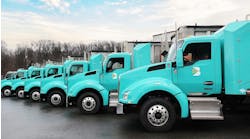Manual transmissions still have their place in the heavy duty market, and likely will for some time. But automated manual transmissions (AMTs) are quickly taking up more market share than ever before – and for good reason.
“When we look at Volvo Trucks’ customer base, we see a clear distinction,” said Johan Agebrand, product marketing manager at Volvo Trucks North America. “Fleets using AMTs are performing better and growing in their businesses compared with those using manual transmissions in the same segments and applications.”
AMTs tend to be more efficient, require less preventive maintenance, and – perhaps most importantly – require less experienced drivers.
Chad Seth, director of truck sales at Rihm Kenworth, agreed. He noted Rihm Kenworth customers are purchasing AMTs over manual transmissions by a wide margin.
“Our current deliveries in 2020 and 2021 have been roughly 75 percent [or more] AMT or automatic transmissions, and I fully expect that number to continue to rise in the future,” Seth said. “I would guess as more AMT configurations [13- and 18-speed] come out with dynamic shifting, that more of the vocational on-highway trucks will also migrate to automated, bringing the percentages even higher.”
Agebrand estimates an even higher rate of sales for AMTs versus manual transmissions when it comes to new heavy duty trucks. He further predicts the demise of the manual sooner than some might expect.
“Depending on annual fluctuations in the size of the Class 8 market overall, Volvo Trucks’ market share for AMT versus manual has stabilized at around 95 to 98 percent for AMT and 2 to 5 percent for manual,” Volvo’s Agebrand said. “Based on transformational changes moving our industry toward fossil-free and CO2 neutral solutions, manual transmissions will likely be dropped from all major OEM portfolios within the next five to ten years.”
Eaton predicts that AMT penetration will increase in the future due to more stringent emissions regulations coming in 2024 and beyond, noted Becky Parsons, global clutch product strategy manager at Eaton Vehicle Group.
“This will require even more integration between the engine and transmission and how they work together to improve fuel economy,” Parsons said. “That’s something you can’t do with a manual transmission.”
Read more about manual transmission and AMT spec'ing and maintenance.




